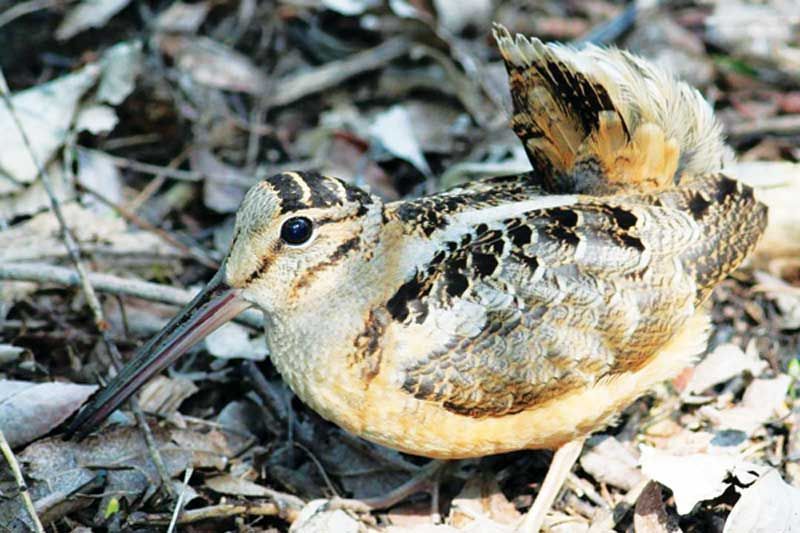Lorraine Julien | Mar 23, 2016
An early and familiar sign of spring in the Land O’Lakes is the spectacular breeding display of the male American Woodcock. Once this pint-size shorebird arrives on its territory in late March or early April, it begins its territorial displays with a series of “peent” calls given from a clearing on the ground, followed by an upwardly spiraling flight display. As it whirs upwards, the bird’s wings whistle loudly as it performs its “sky dance” before it plummets back to the ground accompanied by a series of liquid chirping calls to resume its “peents”.
I heard and saw my first woodcock of the year on March 16, a bit earlier than most years. I was out for a walk and about 20 minutes after sunset a woodcock repeatedly went through its aerial display overhead and on the ground nearby. After one of its aerial displays, it dropped to the ground about 10 meters in front of me, and I was quite surprised how loud its “peents” were.
The American Woodcock is the only shorebird (or sand-piper like birds) that makes its home, both winter and summer, in the forest. In the summer, it breeds in young moist deciduous forests with suitable clearings. The female lays about 4 eggs on average in a simple depression in the ground, and is reported to sit so quietly that she can be touched. In winter, woodcock seek similar young moist forests in the southeastern US. Highest densities of woodcock in winter are apparently found in northern Alabama. The southern migration of these birds from our area is well underway by mid-October, with the bulk having departed for their winter homes by mid-November.
The woodcock is a plump 10-12 inch (25-30 centimeter) bird with almost no neck and slender legs. A woodcock’s large eyes are located far back on its head so that it can see predators while it’s feeding. Ear holes slightly in front of the eyes help locate earthworms, which make up about 80 percent of its diet. Their long, slender bills with their flexible tips are perfectly suited for probing in moist forest soils for worms, insects and other invertebrates.
This species has several other interesting colloquial names, including timberdoodle, Labrador twister, night partridge and my personal favourite, bog sucker. The male and female woodcock are identically coloured in mottled earth tones which closely match the colours of the forest floor. It is a “crepuscular” species – in other words, it is most active around dawn and dusk and very secretive and inconspicuous at other times during the day.
Numbers of woodcock are believed to have increased in Ontario during the 19th century as settlers cleared the forests, providing the openings and younger forests preferred by the species. In addition, earthworms were introduced from Europe during this period. Earthworms native to Ontario were eliminated during the last ice age.
Woodcock populations are believe to have declined in Ontario since the 1960s, although the evidence seems to suggest that this decline may have slowed beginning in the mid-1990s. The main reason for the decline in Ontario is that many young forests with openings are maturing and the openings closing in, and in other areas, young forests are being cleared for housing and agriculture. However, despite these declines, it continues to be a common breeding bird in southern Ontario.
Now that spring has arrived, listen for the tell-tale “peent” and aerial twittering which lets you know that the American Woodcock is back to claim its woodland territory for another year.
Please send your observations to Lorraine Julien at This email address is being protected from spambots. You need JavaScript enabled to view it. or Steve Blight at This email address is being protected from spambots. You need JavaScript enabled to view it.
More Stories
- Latest CUPW Job Action Stops Postal Delivery Of The Frontenac News Forcing Alternate Plans
- Opponents of Barbers Lake Gravel Pit Pack Ag Hall in McDonalds Corners
- Bobsleigh Olympian Jay Dearborn At Mikes Pizza In Sydenham
- The Loins Club Of and O'Lakes Roar
- North Frontenac Back Roads Studio Tour - September 27 and 28
- Sunday Market Vendors Give Back
- George Street Work As Town Hall Renovation Nears Completion
- One Way Street Plan Hits A Dead End - Central Frontenac Council, September 9
- Global Gardening
- No Winner Yet in Catch The Ace But Fundraising Target Met

